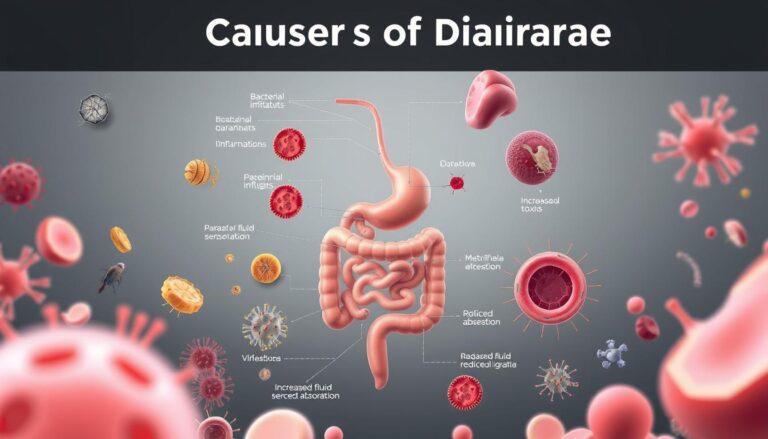Perimenopause Symptoms: 34 Signs You’re in Perimenopause

As you move through midlife, knowing what’s happening is key to your health. Perimenopause is a phase that can last up to 8 years. It’s marked by big changes in hormones.
You might feel many physical and emotional symptoms during this time. These can change your daily life. Spotting these signs is the first step to handling them better. This phase usually happens between 40 and 55 years old. It’s a natural part of growing older.
Key Takeaways
- Perimenopause is a transitional phase leading to menopause.
- It can last up to 8 years and starts 4-10 years before menopause.
- Hormonal fluctuations cause various physical and emotional symptoms.
- Understanding these symptoms is key to managing them.
- The perimenopause age range typically spans from 40 to 55 years.
Understanding Perimenopause: What Is It?
Perimenopause is more than just a step before menopause. It’s a unique phase with its own challenges and symptoms. Knowing what’s happening in your body can really help.
Definition of Perimenopause
Perimenopause is the time before menopause when you might feel different because of hormone changes. It can last from a few months to a few years. It marks the end of your childbearing years.
Key characteristics of perimenopause include:
- Hormonal fluctuations
- Irregular menstrual cycles
- A range of physical and emotional symptoms
Phases of Perimenopause
Perimenopause has two main stages: early and late. The early stage brings small changes and mild symptoms. The late stage brings more severe symptoms and irregular periods.
Knowing these stages helps you get ready for what’s coming. Here’s what you need to know:
- Early stage: Mild symptoms, subtle changes in menstrual cycle
- Late stage: More severe symptoms, significant irregularity in periods
Importance of Awareness
Knowing about perimenopause and its signs is key. It’s not just about stopping periods. It’s about hormone changes that can affect your health in many ways.
By understanding perimenopause, you can:
- Better manage your symptoms
- Seek appropriate medical guidance when needed
- Prepare for the transition to menopause
Common Symptoms of Perimenopause
Knowing the common symptoms of perimenopause is key to managing them. This phase brings physical and emotional changes that can affect your daily life.
Recognizing the Symptoms
Perimenopause symptoms vary among women. But many share common ones. These include hot flashes, night sweats, irregular periods, and mood swings.
Hot Flashes and Night Sweats
Hot flashes are sudden feelings of heat. They can make you sweat and flush. They happen more at night, causing night sweats that can mess up your sleep. “It’s like my body just decides to turn up the heat without warning,” many women say.
Managing hot flashes means making lifestyle changes. Dress in layers and avoid spicy foods or hot drinks.

Irregular Periods
Irregular periods are a big sign of perimenopause. You might have longer or shorter cycles, or even skip periods. This change can be unsettling, but it’s part of the transition to menopause.
“The change in my periods was the first sign that my body was undergoing perimenopause. It was a mix of irregularity and intensity that caught me off guard.”
Mood Swings
Mood swings are common, caused by hormonal changes in perimenopause. You might feel irritable, anxious, or depressed without a clear reason. Seeing these mood swings as part of perimenopause can help you cope better.
Strategies like mindfulness, exercise, and therapy can help. By understanding and addressing these symptoms, you can navigate perimenopause better and live a healthier life.
Physical Changes During Perimenopause
Perimenopause brings many physical changes that can be tough to handle. It’s key to know what’s happening and how to adjust.
Weight Gain and Body Changes
Weight gain, often around the belly, is a common change. Hormonal shifts and metabolic changes cause it. Eating well and exercising regularly can help.
Skin and Hair Changes
Perimenopause can also affect your skin and hair. You might see dryness, thinning, or increased sensitivity in your skin. Hair texture or hair loss can change too. Lower estrogen levels cause these issues. A good skincare routine and gentle hair care can help.
Sleep Disturbances
Sleep problems are common during perimenopause. Hot flashes and night sweats can mess with your sleep. A calm bedtime routine and a cool sleep space can help.
“The key to managing perimenopause symptoms is understanding your body and making informed lifestyle choices.”
Knowing about these changes and taking action can make perimenopause easier to handle.
Emotional and Psychological Symptoms
As you go through perimenopause, you might feel many emotional and psychological changes. These can be as tough as the physical ones. They often come from hormonal changes that affect your mind and how you feel.
Anxiety and Depression
Anxiety and depression are common in perimenopause. Hormonal shifts can make you feel uneasy and sad. It’s key to spot these signs early. Getting help from doctors or loved ones can really help.
- Recognizing the signs of anxiety and depression
- Understanding the impact of hormonal changes
- Exploring treatment options and support systems
Memory Issues
Memory problems, or “brain fog,” are common in perimenopause. You might struggle to focus or remember simple things. But, there are ways to deal with these issues.
- Staying organized with calendars and reminders
- Engaging in mentally stimulating activities
- Practicing stress-reducing techniques
Mood Fluctuations
Mood swings are a big part of perimenopause. They can make you feel irritable or very emotional. Knowing these swings are due to hormones can help you handle them better.
By understanding these emotional and psychological symptoms, you can start managing them. It’s important to focus on your mental health during this time. Don’t hesitate to seek help when you need it.
Changes in Menstrual Cycle
Perimenopause brings changes to your menstrual cycle. You might notice changes in how often, how much, and how long your periods last. These changes can be unpredictable and may worry you. But knowing they’re a natural part of this transition can help you feel better.
Frequency of Periods
Perimenopause can make your periods irregular. You might have closely spaced periods or long gaps between them. These changes happen because of hormonal shifts, like a drop in estrogen levels.
Tracking your periods is key to understanding these changes. A menstrual diary or a period-tracking app can help you spot patterns and any unusual changes.
Changes in Flow
Your period flow can also change a lot. Some women might have heavier flows, while others have lighter flows. These changes can be a hassle and might mean you need to change your sanitary products or clothes more often.
Knowing these changes are part of perimenopause can help you prepare. Keep sanitary products ready and wear layers to manage unexpected flow changes.
Duration of Periods
How long your periods last can also change. Some might be shorter, lasting just a few days. Others might last longer, going beyond the usual 5-7 days. These changes can be hard to deal with, but knowing they might happen can help you plan.
Remember, while these changes can be a bit of a challenge, they’re usually normal in perimenopause. But if you have very heavy or long periods, see your doctor to check for any health issues.
Sexual Health and Libido
Perimenopause can change your sexual health and libido in unexpected ways. It affects not just your body but also your intimate life. Understanding these changes is key to moving through this phase with confidence.
Decreased Sexual Desire
Many women experience a drop in sexual desire during perimenopause. Hormone changes, like lower estrogen, play a big role. It’s important to know this is a normal part of the transition.
Talking openly with your partner about your feelings can strengthen your bond. Trying new ways to be intimate that aren’t just about sex can also help.
Vaginal Dryness
Vaginal dryness is another common symptom. Lower estrogen levels make vaginal tissues thinner and drier. Using lubricants and moisturizers can help make sex more comfortable.
“Vaginal estrogen therapy can be an effective solution for some women, helping to restore the natural moisture and elasticity of the vaginal tissues.”
Increased Urinary Issues
Perimenopause can also cause more urinary problems, like incontinence. Weaker pelvic floor muscles are often to blame. Doing pelvic floor exercises, like Kegels, can help strengthen these muscles and lower incontinence risk.
Keeping a healthy lifestyle, with a good diet and exercise, supports your sexual health during this time.

Sleep Problems
As you go through perimenopause, you might find it hard to sleep. Sleep issues are common and can really affect your life. They can make you feel less well and lower your quality of life.
There are different sleep problems during perimenopause. These include insomnia, sleep apnea, and nighttime awakenings. Hormonal changes, hot flashes, and night sweats can make these worse.
Insomnia
Insomnia is when it’s hard to fall or stay asleep. Hot flashes and night sweats can make it even harder. A calm bedtime routine can help with insomnia.
Sleep Apnea
Sleep apnea is another issue that can happen during perimenopause. It’s when you stop breathing for short times while sleeping. If you snore loudly or have morning headaches, see a doctor.
Nighttime Awakenings
Nighttime awakenings are common too. They’re often caused by hot flashes and night sweats. Waking up a lot can make you tired and affect your day. A good sleep environment can help.
To deal with sleep issues, try changing your lifestyle. Stick to a sleep schedule, avoid caffeine and electronics before bed, and make your bedroom cozy. If problems keep happening, talk to a doctor.
“Sleep is the golden chain that ties health and our bodies together.” – Thomas Dekker
By tackling sleep problems and improving your sleep, you can feel better during perimenopause.
Managing Perimenopause Symptoms
You can control your perimenopause symptoms by making smart choices. Perimenopause treatment includes lifestyle changes, diet, and exercise.
Simple daily changes can help a lot. Stress management like meditation or yoga can reduce anxiety. It also boosts your well-being.
Lifestyle Changes
Some lifestyle changes can help manage symptoms. Here are a few:
- Avoid spicy foods and caffeine to prevent hot flashes
- Stop smoking to avoid osteoporosis and heart disease
- Try relaxation techniques to handle stress and anxiety
Diet and Nutrition
Eating well is key to managing symptoms. Include foods like:
- Calcium and vitamin D for bone health
- Omega-3 fatty acids in fish and nuts to fight inflammation
- Fruits and vegetables for antioxidants and fiber

Exercise Benefits
Exercise is a big part of perimenopause treatment. It can:
- Strengthen bones and prevent osteoporosis
- Improve heart health and lower heart disease risk
- Boost mood and lessen anxiety and depression
Try a mix of cardio, strength, and flexibility exercises. You’ll see the benefits.
By making these lifestyle changes, you can manage your symptoms. This will also improve your life quality.
When to Consult a Doctor
If you’re feeling the signs of perimenopause, knowing when to see a doctor is key. This stage is natural, but some symptoms can really affect your life. Or, they might show other health problems.
Recognizing Severe Symptoms
Some symptoms need a doctor’s help right away. These include very heavy or long periods, bad hot flashes, and big mood swings. If you’re dealing with these, you should talk to a healthcare provider.
Key symptoms to watch out for:
- Heavy or prolonged menstrual bleeding
- Severe hot flashes or night sweats
- Significant mood swings or depression
- Sleep disturbances that persist
Importance of Professional Guidance
Getting help from a doctor is more than just dealing with symptoms. It’s also about checking for other health issues that might be linked to perimenopause. A doctor can give you advice, treatment options, and reassurance.
Don’t hesitate to seek help if you’re struggling with your symptoms. Talking to a doctor can help you get through this time smoothly.
Knowing your symptoms and when to see a doctor can help you manage your health during perimenopause. Remember, your healthcare provider is there to support you.
Health Implications of Perimenopause
As you go through perimenopause, knowing about long-term health risks is key. The drop in estrogen levels can raise your chance of getting certain health problems.
Long-term Health Risks
Perimenopause symptoms might signal bigger health issues like osteoporosis and heart disease. Knowing the signs and acting early can lower these risks.
Bone Health and Osteoporosis
Less estrogen can cause bone loss, raising osteoporosis risk. Eating well, with lots of calcium and vitamin D, and exercising regularly can protect your bones.
Heart Health Considerations
Perimenopause can change your lipid profiles and blood pressure, affecting heart health. Keeping an eye on these and living a heart-healthy life can cut down heart disease risk.
Understanding perimenopause’s health effects and taking steps to prevent them can keep you healthy. This way, you can avoid long-term health problems linked to perimenopause symptoms.






